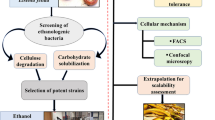Abstract
A laboratory scale study to evaluate the potentiality of filamentous fungi for the production of cellulolytic enzymes using palm oil mill effluent (POME) as a basal medium was initiated. A total of 25 filamentous fungi in which 16 filamentous fungi were isolated and purified from oil palm industrial residues and 9 strains from laboratory stock were screened using POME with 1% total suspended solids. Trichoderma reesei RUT C-30 was identified as a potential strain for cellulolytic enzyme production as compared to other genera of Aspergillus, Penicillum, Rhizopus, Phanerochaete, Trichoderma and basidiomycete groups. The results showed that T. reesei RUT C-30 gave the highest filter paper cellulase and carboxy methyl cellulase activity of 0.917 and 2.51 U/ml respectively at day 5 of fermentation. Other parameters such as growth formation, pH, filterability and total biosolids were observed to evaluate the bioconversion process.



Similar content being viewed by others
References
Ahmad AL, Ismail S, Bhatia S (2005) Ultrafiltration behavior in the treatment of agro-industry effluent: pilot scale studies. Chem Eng Sci 60:5385–5394
Ahmed AL, Chong MF, Bhatia S, Ismail S (2006) Drinking water reclamation from palm oil mill effluent (POME) using membrane technology. Desalination 191:35–44
Alam MZ, Fakhru’l-Razi A (2003) Enhanced settleability and dewaterability of fungal treated domestic wastewater sludge by liquid state bioconversion process. Water Res 37:1118–1124
Alam MZ, Fakhrul-Razi A, Molla AH (2004) Evaluation of fungal potentiality for bioconversion of domestic wastewater sludge. J Environ Sci 16:132–134
Alam MZ, Muyibi SA, Wahid R (2008a) Statistical optimization of process conditions for cellulase production by liquid state bioconversion of domestic wastewater sludge. Bioresour Technol 99:4709–4716
Alam MZ, Jamal P, Nadzir MM (2008b) Bioconversion of palm oil mill effluent for citric acid production: statistical optimization of fermentation media and time by central composite design. World J Microbiol Biotechnol 24:1177–1185
APHA (1989) Standard methods for the examination of water and wastewater, 17th edn. America Public Health Association, Washington
Arhan Y, Oztuk I, Ciftci T (1996) Settling and dewatering characteristics of sludge from Baker’s yeast production wastewater treatment. Water Sci Technol 34:459–467
Bedford M (1995) Mechanism of action and potential environmental benefits from the use of feed enzymes. Animal Feed Sci Technol 53:145–155
Buchert J, Heikinheimo L (1998) New cellulase processes for the textile industry. Carbohyd Europe 22:32–34
Fakhru’l-Razi A, Alam MZ, Abd-Aziz S, Molla AH (2002) Filamentous fungi in Indah Water Konsortium (IWK) sewage treatment plant for biological treatment of domestic wastewater sludge. J Environ Sci Heal A37:309–320
Ghose TK (1987) Measurement of cellulase activities. Pure Appl Chem 59:257–268
Hassan MA, Yacob S, Shirai Y (2004) Treatment of palm oil wastewaters. In: Wang LK, HungY LoHH, Yapijakis C (eds) Handbook of industrial and hazardous wastes treatment. Marcel Dekker Inc, New York, pp 719–736
Heikinheimo L, Buchert J, Miettinen-Oinonen A, Suominen P (2000) Treating denim fabrics with Trichoderma reesei cellulases. Textile Res J 70:969–973
Ilias GNM (2000) Trichoderma and its efficiency as a biocontrol agent of basal rot of Oil Palms (E. Guineensis). PhD Thesis. Faculty of Science, University Putra Malaysia
Krishna C (1999) Production of bacterial cellulases by solid state bioprocessing banana wastes. Bioresour Technol 69:231–239
Leahy JG, Colwell RR (1990) Microbial degradation of hydrocarbons in the environment. Microbiol Mol Biol Rev 54:305–315
Lee SM, Koo YM (2001) Pilot-scale production of cellulose using Trichoderma reesei Rut C-30 in fed-batch mode. J Microbiol Biotechnol 11:229–233
Lee LB, Mat HB (1998) Biodegradation of lubricating oil by locally isolated bacterial species-microbial identification and degradation potential study. In: Proc 10th National Biotechnology Symp, SIRIM Berhad, Malaysia: 80–85
Macris BJ, Kekos D, Evrangelidou X (1989) A simple and inexpensive method for cellulase and β-glusidase production by Aspergillus niger. Appl Microbiol Technol 31:150–151
Marsden WL, Gray PP (1986) Enzymatic hydrolysis of cellulose in lignocellulosic material. CRC Crit Rev Biotechnol 3:235–265
Molla AH, Fakhrul-Razi A, Alam MZ (2002) Potential resource for bioconversion of domestic wastewater sludge. Bioresour Technol 85:263–272
Olsson L, Christensen TIE, Hansen KP, Palmqvist EA (2003) Influence of the carbon source on production of cellulases, hemicellulases and pectinases by Trichoderma reesei Rut C-30. Enzyme Microb Technol 33:612–619
Outwater AB (1994) Reuse of sludge and minor wastewater residuals. CRC Press Inc, Boca Raton, FL, pp 132–133
Robles A, Lucas R, de Ciefuegos GA, Galvez A (2000) Biomass production and detoxification of wastewaters from the olive oil industry by strains of Penicillium isolated from wastewater disposal ponds. Bioresour Technol 74:217–221
Tolan JS, Foody B (1999) Cellulases from submerged fermentation. Adv Biochem Eng Biotechnol 65:41–67
Vijayaraghavan K, Ahmad D, Ezani A (2007) Aerobic treatment of palm oil mill effluent. J Environ Manag 82:24–31
Xu J, Takakuwa N, Nogawa M, Okada H, Morikawa Y (1998) A third Xylanase from Trichoderma reesei PC-3–7. Appl Microbiol Biotechnol 49:718–724
Yacob S, Hassan MA, Shirai Y, Wakisaka M, Subash S (2005) Baseline study of methane emission from open digesting tanks of palm oil mill effluent treatment. Chemosphere 59:1575–1581
Zakaria MH (1989) Some aspects of the biology and chemically assisted biological control of Ganoderma Species in Malaysia. PhD thesis. Faculty of Science, UPM, Malaysia
Acknowledgments
The authors thank to the Ministry of Higher Education (MOHE) for approval a research grant under Fundamental Research Grant Scheme (FRGS 0207-49). The supply of experimental samples by the Seri Ulu Langat Palm Oil Mill Sdn Bhd and West Oil Mill, Sime Darby Plantation, is acknowledged.
Author information
Authors and Affiliations
Corresponding author
Rights and permissions
About this article
Cite this article
Rashid, S.S., Alam, M.Z., Karim, M.I.A. et al. Management of palm oil mill effluent through production of cellulases by filamentous fungi. World J Microbiol Biotechnol 25, 2219–2226 (2009). https://doi.org/10.1007/s11274-009-0129-9
Received:
Accepted:
Published:
Issue Date:
DOI: https://doi.org/10.1007/s11274-009-0129-9




